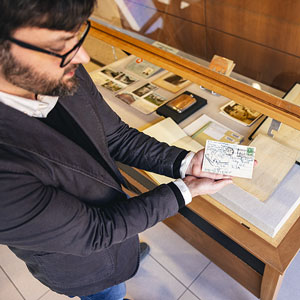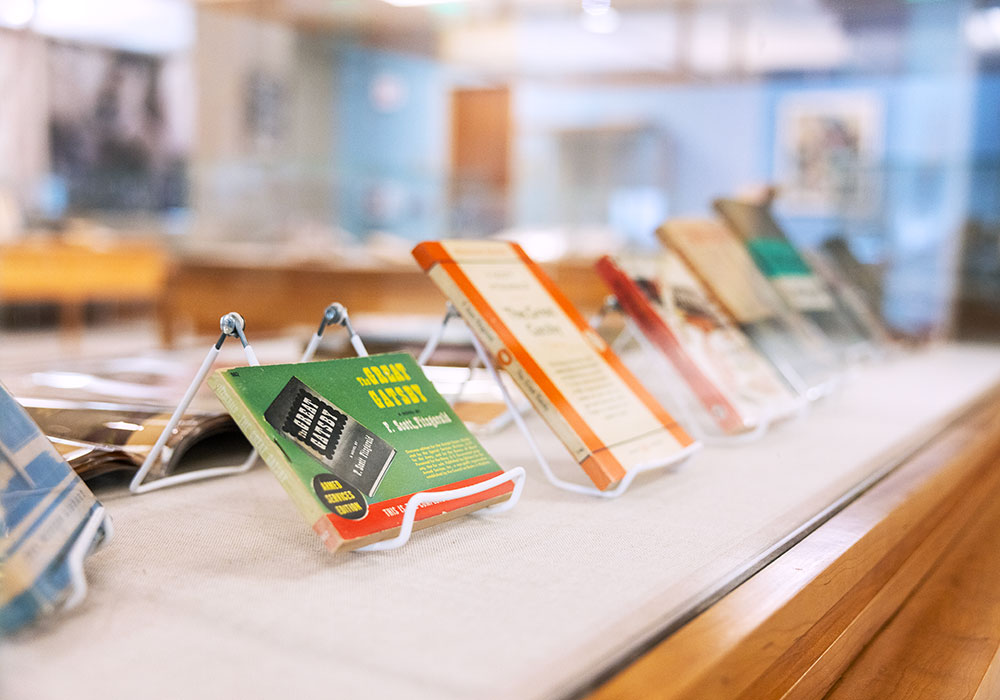Some novels pull you in and won’t let go. Others jump right up off the page. Still others, a select few, gain such a firm foothold in popular culture that even people who haven’t read them might at least know what they’re about.
Over the last 100 years, F. Scott Fitzgerald’s The Great Gatsby has done all of the above. Now, the Irvin Department of Rare Books and Special Collections at University of South Carolina Libraries is celebrating the famous Jazz Age novel’s centennial with a special exhibition at USC’s Hollings Library.
“‘Something significant, elemental and profound’: Celebrating 100 Years of The Great Gatsby,” which opens Jan. 24 and runs into July, draws primarily on the university’s Matthew J. & Arlyn Bruccoli Collection of F. Scott Fitzgerald.
A longtime mecca for Fitzgerald scholars, the Bruccoli collection was compiled over several years by late USC English professor Matthew Bruccoli. It contains more than 4,400 books and periodical titles by and about F. Scott Fitzgerald, including every printing of every Fitzgerald book in the English language. It is also home to an array of Fitzgerald manuscripts, correspondence, photographs and memorabilia.
Naturally, The Great Gatsby is well-represented in the collection, and why not? Despite initially poor sales — between its publication in April 1925 and Fitzgerald’s death in December 1940, it sold fewer than 25,000 copies — the iconic literary romance has become a perennial bestseller, a classroom standard and a Hollywood favorite.
“The core of the exhibit is really focused on Gatsby because of the 100th anniversary,” says Michael Weisenburg, director of the Irvin Department and the exhibit’s curator. “But we’re also doing what we can to round out Fitzgerald as a person, his life and his world, and also the world that he's representing in the novel.”
Highlights include: a first edition of The Great Gatsby with the dust jacket; corrected galley proofs from Scribner’s, Fitzgerald’s publisher; writer Sylvia Plath’s heavily annotated copy of the novel; Fitzgerald’s ledger, which chronicles the author’s ambitious work schedule and finances; even a silver flask given to Fitzgerald by his wife, Zelda, when the two were still courting.
“The flask has to be in the exhibit because it's awesome and people love seeing it,” says Weisenburg. “And it helps contextualize Scott and Zelda's relationship.”
Fitzgerald’s biography — and particularly his relationship with Zelda — appeals to many people because of their complicated romance, Weisenburg contends. Similarly, the romance of Jay Gatsby’s efforts to win the heart of Daisy Buchanan in the novel has helped to sustain the novel’s popularity for the past 100 years.
It's world building. I want to tell the story of the creation of the novel and then tell the story of the afterlife of the novel. It's a narrative as you move through, but I also know that people will meander and wander, and that's fine too. Each case is its own thing. But if you walk through the exhibit as it’s arranged, you should get a good story.
“It's about desire. It's about striving. It's a rags-to-riches story,” says Weisenburg. “But it’s also about the dark side of the American Dream, right?”
And those themes transcend the printed page. In fact, many visitors will have been introduced to The Great Gatsby not through the novel but through the 2013 Baz Luhrmann film adaptation starring Leonardo DiCaprio as Gatsby. Or the 1974 Jack Clayton adaptation starring Robert Redford. Or even the 1949 Elliott Nugent adaptation starring Alan Ladd …
OK, most visitors probably won’t be familiar with Nugent’s black-and-white adaptation, which lit up the silver screen less than a decade after Fitzgerald’s death, but that’s part of the exhibit’s function: to entertain but also educate.
“Gatsby was adapted immediately, originally on Broadway, or just off Broadway,” says Weisenburg. “Then there was a production in London. Then there was a silent film. Most of that film is lost, but there's fragments of it, and we have one of the glass marquee cards. So, if you want to know the whole history of Gatsby on stage and onscreen, we have a case that contextualizes that from the ’20s to the present.”

Weisenburg has also curated interpretive cases on 1920s car culture, which features prominently in the book, and on jazz. He also included other relevant items from the library’s holdings to enhance the experience. As an example, he cites a contemporaneous novel titled Simon Called Peter, by Robert Keable.
The title is not likely to ring many bells today, but in the 1920s it was a bestseller — and for Fitzgerald, a sort of shorthand way to characterize (and yes, satirize) Tom Buchanan’s mistress, Myrtle Wilson.
“Fitzgerald mentions Simon Called Peter in his novel. It's something that Nick Carraway, the narrator, sees in Myrtle’s apartment,” Weisenburg explains. “Fitzgerald thought it was a terrible book, so he has Tom’s mistress reading what he thinks is bad literature to signify that she doesn't have a sense of class or aesthetics.
“It's not part of the Bruccoli collection. We just have a copy of it because it was a popular book at the time, so we pulled that from the annex, and we put it in.”
Taken as a whole, the exhibit offers its own narrative, and Weisenburg approached it the way he would any other large special collections exhibit: as a storyteller.
“It's world building. I want to tell the story of the creation of the novel and then
tell the story of the afterlife of the novel,” he says. “It's a narrative as you move
through, but I also know that people will meander and wander, and that's fine too.
Each case is its own thing. But if you walk through the exhibit as it’s arranged,
you should get a good story.”
